This article is a Community Post written by guest contributor Ian Howard. If you’re interested in writing a guest piece at Pitcher List, send us an email at Community@PitcherList.com
On the cusp of turning 30-years old, DJ LeMahieu has crossed the half decade threshold of holding down the 2B position in the Mile High (heh heh) city. The 2016 & 2017 campaigns looked promising for LeMahieu, carrying a .328 batting average over the past two seasons while flirting with 200 hits in each of those seasons. Carrying a high BABIP in both ‘17 &’18 (.388 & .351 respectively) suggests he was getting quite lucky on some balls in play, but the elite contact percentage has been there and seems to only be improving. It’s no secret that LeMahieu could hit for average and be depended on to be a guy who scores a lot of runs. As the first month of the season dwindles down to its final days, we see some of our pre-season predictions come true, and we smugly remind our friends and colleagues who had opposing pre-season opinions how wrong they were, and pat ourselves on the back until it welts up. Of course when our pre-season predictions go up in flames, we can just chalk it up “Baseball, man. Crazy, unpredictable game.” So who am I hoping to be able to pat myself on the back about? I truly believe that DJ LeMahieu is showing us that his ceiling is higher than most initially anticipated it to be, particularly in the power department.
A few things catch my eye when looking at what he’s doing this year that he doesn’t done in years past. He has shown that he is .300 hitter, and if any of his April 2018 batted ball data is indicative of the type of hitter he will be this year, then Rockies fans are in for a treat. So far, he is sporting a BABIP of .299, which has been slowly creeping up the past week or so, however it does seem it’s coming back down to earth after two seasons with a BABIP over .350. However, it’s important to note that BABIP does not take HR into consideration, so that .299 figure might be a tad misleading. Trying to get a more legitimate idea of his performance, I looked into his xStats (explained very well here by PitcherList) and saw his xBacon sitting at .342, which wouldn’t quite put him in elite territory. However, his OUTs score of .150 DOES have him entering excellent territory, which could be indicative of a big turnaround, considering he finished with an abysmal OUTs score of .017 last year.
What were we talking about again? Oh yeah: dingers. This was supposed to be about how LeMahieu will treat the fine fans of Denver to more dingers. Everybody loves dingers. I think he has a very good chance at breaking his season high record of a whopping 11 HR- thanks in part to this more fly-ball oriented approach he is taking at the plate, his Zcontact% going up (#2 in the MLB with 96.6%) paired with a declining SwingO% , he is a prime candidate to hit at least 15 homers for the first time in his career.
Let’s look at a couple things – he is hitting more fly balls, and way more of those fly balls are clearing the fence. Like WAY more. 10.2% HR/FB in 2016, followed by a dip down to 7.8% last year. As April closes out, his HR/FB has skyrocketed, sitting at 18.5%. It’s actually such a big jump, it’s almost perplexing, because it’s obvious that like many hitters around the league, he has shifted his approach to hitting more fly balls (LAUNCH ANGLES BABY) but it’s hard to say if his approach is sustainable. LeMahieu has always been around 55% when it comes to his GB%, and while his GB% has stayed roughly the same, it’s all the more obvious that this increase in FB% has come directly at the expense of his LD%.
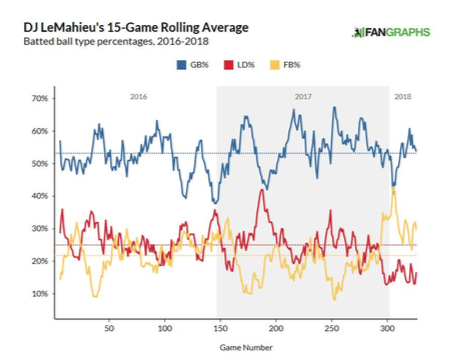
After wrapping up 2017 with a LD% of 24.7, that’s dropped down over 5% to 19.6%. This shouldn’t come as a surprise when many guys around the league have been nudged towards taking a more fly-ball oriented style of approach at the plate. It’ll be interesting to see players hit more HR, but league wide K-rates will continue to increase exponentially. I suspect FB% increasing in sacrifice of LD% will be a much more common trend in the coming years.
For a guy who has been known to hit to the opposite field well and often during his career, it sure is interesting looking at how his pull rate jumped up nearly 10% from 2017 to this year. In fact for the past three seasons, he has maintained a roughly 20% pull rate. That has jumped up to 31.5% this year.
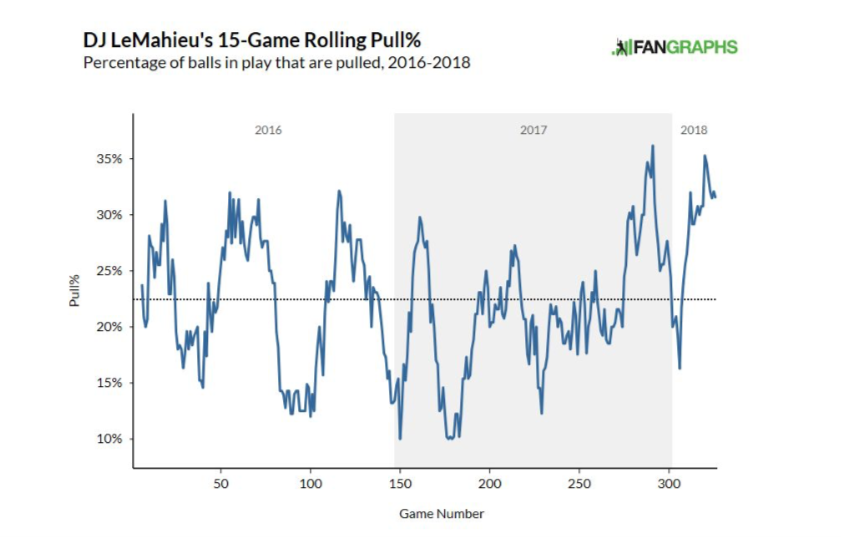
Along with that increased pull rate, we take a look at his spray charts from 2017 and 2018:
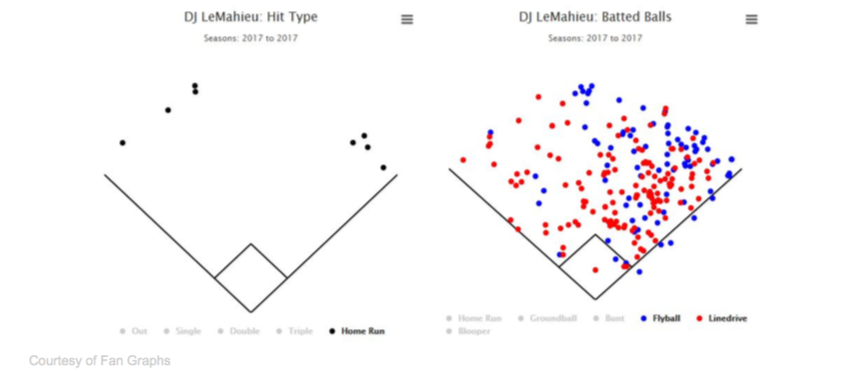
The big difference I see so far is that while he split his homers to the left and right side of the field, while all but one of his homers so far this year have been pulled. Not only that, but every single one of his home runs this year have been hit on the road, so anybody who thinks any power can be attributed to Coors can cross that off. More of his fly balls appear to be being pulled as well. Something I wasn’t expecting to see was the majority of his line drives being hit to the opposite field. I said earlier that his increase in FB% came at expense of his LD%.
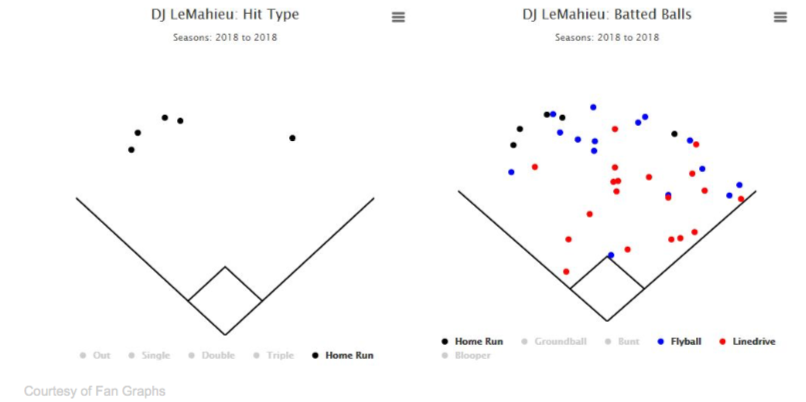
I thought that could also lead to more outs. While his percentage of balls in play being hit to the opposite field is down around 10% from the past couple seasons, it seems that he is still showing us that he doesn’t have to sacrifice power to show he can still stroke line drives into right field. He is still demonstrating a strong ability to drive the ball to opposite field, but overall his power is being demonstrated through his fly balls and home runs that are being pulled.
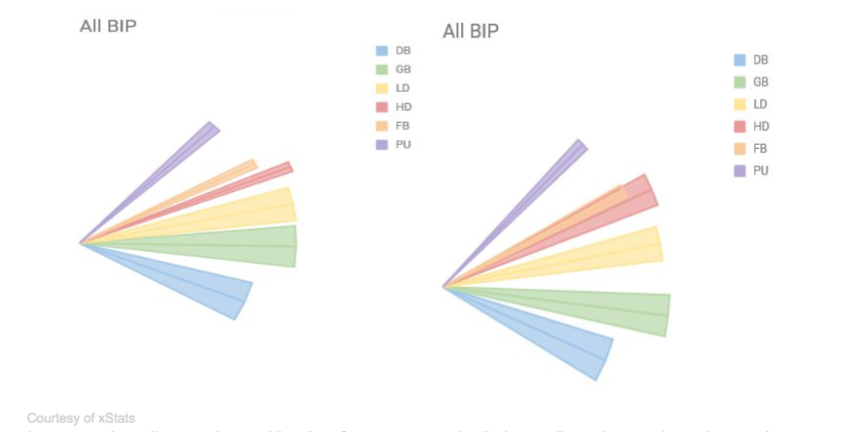
Increases in pull rate, along with other factors can typically be attributed towards a players rise in power. One of the most overlooked, but telling stats to determine power is high drive rate.
Per xStats, High Drives are the most valuable batted balls. “They only represent about 10% of batted balls, but 90% home runs and 34% of doubles.” . If you compare 2017 (left) to 2018 (right) LeMahieu has had a 10.3% uptick in his HD%. (6.0% → 16.3%) That’s mighty encouraging to see in a 2B who plays at Coors.
Increases in stats like pull%, HR/FB, HD%, etc. tend, to be seen in hitters who are trending towards developing more power. On the other side of the coin, it is only fair to be mindful of when being presented with such a small sample size, and other red flags. One of these red flags is his average launch angle. While Lemahieu has never had a crazy high average launch angle, you’d think based off his increased HR/FB rate, pull rate, etc, you wouldn’t see such a low average launch angle so far this year (3.8 degrees). However, this is a guy who’s GB% has sat at >50% his entire career, and the thing about his low average launch angle is that it is pretty consistent with somebody who has GB% > 50% throughout their career. In fact, the main reason why analysts say LeMahieu will never hit for power is his high GB%, and they could be right. But, as discussed earlier, he is hitting more fly balls at the sacrifice of line drives, so the low average launch angle isn’t as alarming as it seems at first glance. If his FB% were going down, then his power would be a concern. His xHR of 3.9 is not a big enough difference compared to his actual total to diminish the value of his HR/FB rate thus far.
Look, I don’t think LeMahieu will be your fantasy team’s saving grace, nor do I think he is going to have a “superstar” year, but I think it’s fair to say that he has been fairly underrated, which is totally understandable when you’re sitting in a lineup with the likes of Nolan Arenado and Charlie Blackmon– Two 1st round picks for fantasy this year. As long as LeMahieu can maintain this FB% to LD% ratio, plus the statistics mentioned above, his GB% doesn’t scare me away from thinking he has the ability to improve his power. His batted ball data surely indicates he can still hit for average, but with a bit more pop than we’re used to seeing from him.
Ian Howard is a 24-year old, 4-time Little League All Star. His life growing up consisted of bullpen sessions, striking out on high cheese at the plate, and now an absolutely trashed UCL in his pitching elbow. He has been obsessed with Giants baseball since his first game at the luxurious Candlestick Park. He still can’t remember crying harder than he did in October 2002 (2010, 2012, 2014 are years he’ll always cherish). Former UCSB Baseball play-by-play radio commentator. Media Buying is his life 9-5, but his passion lies in not only writing about sports, but pretending he actually knows what he’s doing when it comes to predicting who will be good before other people realize they will. UCSB Alum. Beat LA. Hum Baby.
